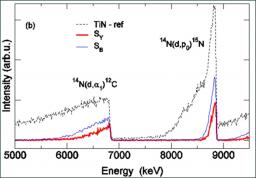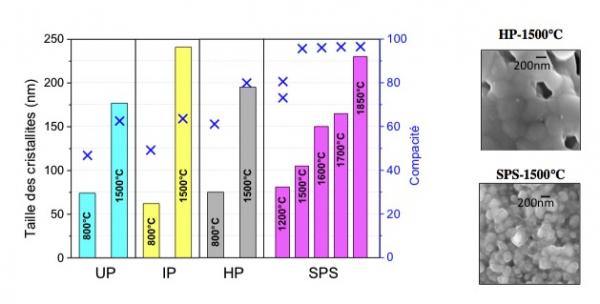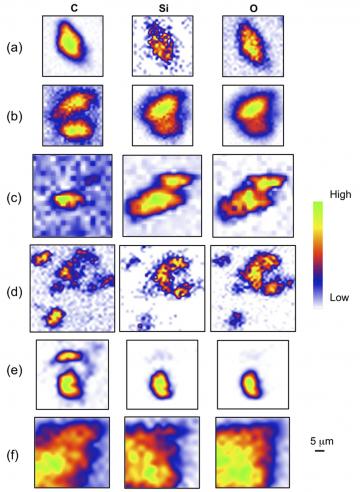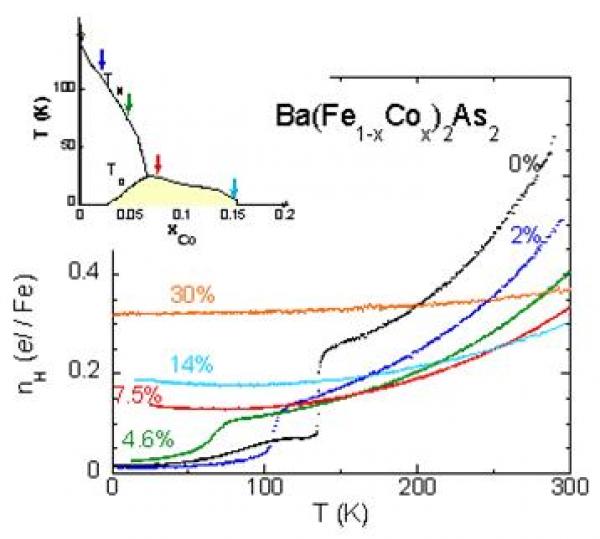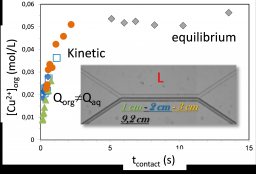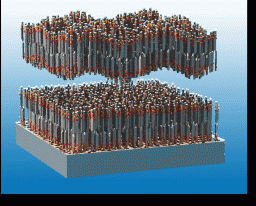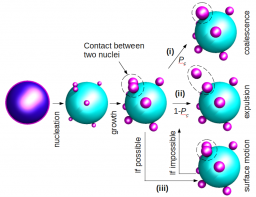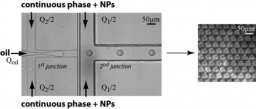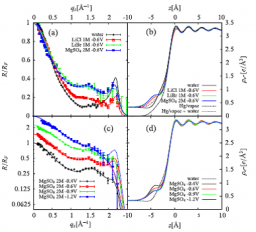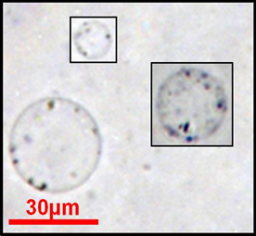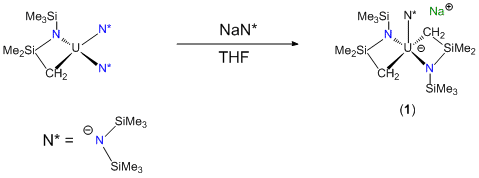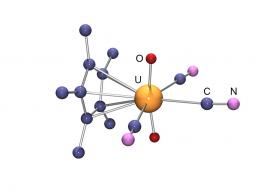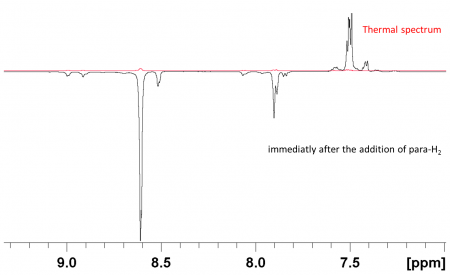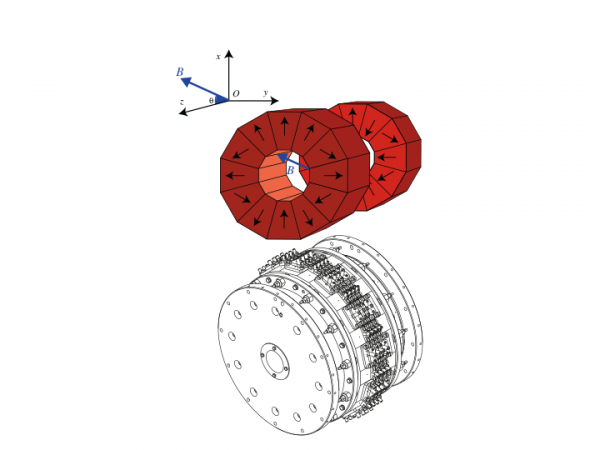2013
We use time-resolved fluorescence spectroscopy from the femtosecond to the nanosecond time scales to study the dynamics of the interaction between various types of drugs (anti-inflammatory, antitumor, antidiabetic..) and biomolecules (DNA, G-quadruplexes, aninoacids, glycogen…).
These studies are performed in the frame of SLIC/LaserLab Europe in collaboration with colleagues from Germany, Spain, Italy and Greece.
Head of the Team: Lionel Poisson
This team is interested in the ultrafast reaction dynamics of perturbed systems (on the 10fs to 100 ps timescale). Initially devoted to isolated species (gas phase), this laboratory is more and more interested in more complex systems clause to the condensed phase: radicals, microsolvated molecules, nanoparticles,…
The goal is to characterize the whole dynamics of a defined system, investigating the relaxation dynamics of all its electronic structures. This is called the “dynamic mapping” of the molecule. The understanding of the results collected goes through theoretical calculations. At least the local environment of the chromophore has to be evaluated by molecular dynamics calculations. Since the photoelectron spectroscopy is used both for the dynamics and spectroscopic investigations, knowing the electronic and vibrational spectroscopy of the ion is also requested.
Head of the team: Marc Briant/Marc-André gaveau
The general objective is to unravel through which mechanisms solvation affects the dynamics of reactions. Both reactions of electronically excited and ground state species are considered. Two set-up are used for this purpose:
Head of the team: Christian Angelié/Jean-Maïk Soudan
The general objective is to give a realistic numerical basis to fundamental concepts such as phase transition, chemical segregation and auto organization in Iron/Carbon systems, in relation with the CNT growth on iron catalysts. Novel algorithms and home-made codes are developed to treat of clusters carrying up to a few thousands of atoms. This work develops along two lines:
Magnetoresistance, giant or tunnel, is at the heart of several spintronic components, a new branch of electronics based on the spin of the electron with applications in information technology. Because of the never ending drive for miniaturization, spintronics is about to reach the ballistic regime of electronic transport for which spin dependent properties are still not completely understood. Further size reductions can even be achieved in constrictions of atomic sizes obtained by slowly stretching a nanostructure in a sensitively controlled manner. In these systems, static magnetotransport measurements result from the low-dimensional magnetism of a few relevant atoms. In parallel ferro-magnetic resonance (the magnetization precession induced by a radio-frequency magnetic field) has seen a renewed interest lately as it has been shown that magnetization dynamics interacts with spin currents. Its correlation with DC transport is being widely studied and it is now possible to electrically measure ferromagnetic resonance using the inverse spin Hall effect or the Anisotropic Magneto-Resistance (AMR).
The latter can be scaled down to atomic sizes thus giving the possibility to open the unknown field of the dynamical magnetic properties of a single atom in a low dimensional local geometry. We have very recently demonstrated that FMR can be detected in narrow constrictions using the AMR mixed with the RF current auto induced in the magnetic circuit, leading to a measurable DC voltage. After a strong experimental effort, an original setup has been built which allows us to electrically detect the ferromagnetic resonance at 77K in samples that can be broken in real time during the measurements. This unique tool will allow us to study the resonance properties of a single atom in a low-dimensional configuration. It may even allow us to demonstrate that some metals like platinum could become magnetic in these atomic contacts.
Post-doc financé par une bourse européenne "Marie Curie Intra-European Fellowship".
Titanium and its alloys are widely used in aeronautical, marine and chemical industries for their good mechanical properties, high resistance to corrosion, especially in sea water or human body, and low density, about 60% of steel density. However, tribological properties of titanium surface are poor with highly unstable friction coefficients and adhesive wear mechanisms which lead mechanical parts to seize up. Surface treatments are required to improve surface properties, according to the envisioned application.
Nitriding and carburizing are the most commonly used thermochemical treatments, but they must be done in highly oxygen-free atmospheres to avoid titanium oxidation. This rules out the possibility of local treatments. Laser induced modifications offer an alternative tool for modifying the surface composition by insertion of light elements (oxygen, nitrogen, carbon) present in the reactive atmosphere. Modified layers must have a high content of nitrogen to be hard enough to stand up to surface friction, while oxygen, localized in less crystallized phases, is also needed to accommodate friction without failure. Oxynitride formation appears then as ideal to reach optimal resistance.
Leader: Sylvie Marguet
Participants: Aurélie Habert, Jérôme Caron (Master-2), Mohammad Khaywah (Post-doc)
NIMBE/LEDNA (Laboratoire Edifices Nanométriques)
Summary: Our objective is to take advantage of the light-matter interaction in nanohybrids, composed of colloidal gold nanoparticles (AuNPs), whose morphology is optimized, to generate light, heat or charge carriers, depending on the targeted application*.
*This theme is in link to two research groups (GdR) of the CNRS in France. The Or-nano and PMSE GdRs (Molecular Plasmonics and Enhanced Spectroscopy).
… for PLASMONICS: since 2008:
Collaborations : CEA-SPEC; L2n-Troyes; ISMO-Orsay; IS2M-Mulhouse; ILM-Lyon, ...
Plasmonics is a discipline at the interface between physics, chemistry and biology. The excitation of the plasmon resonance of a metallic nanoparticle (NP) generates very intense electromagnetic fields, confined to the surface of the NP, which can be used to enhance or initiate a photochemical reaction in a nearby "chromophore". The confinement of the electromagnetic field around a colloidal NP, monocrystalline and non-rough, is greater than that around the same object manufactured by nanolithography. The relaxation of the plasmon, which accompanies this amplification effect, occurs according to ultra-fast relaxation paths, in competition with each other. Their relative importance depends on the morphology of the NP, its "close" environment and the irradiation mode. Thus, gold nanoparticles can behave as nanosources of light, heat or charge carriers (electron, hole), depending on the predominant deactivation path. In terms of morphology, it is the size, the presence of peaks and the aspect ratio (surface/volume) of the NP that matter. The environment refers to both the "chromophores" adsorbed on the surface of the NP and in particular their energy levels (HOMO-LUMO for a molecule or VB-CB for a semiconductor) as well as the possible presence of a layer at the interface (surfactant residues, insulating layer...). Finally, the irradiation mode, continuous or pulsed at different time scales from micro to femto-second, is also a key parameter for the observation of these three types of nanosources.
We synthesize gold nanoparticles (Au-NP) by careful control of their morphology (size, shape) and crystalline structure. Some of these AuNPs are only produced in a few laboratories around the world. Microplates (triangular, hexagonal or disc-shaped), which are atomically flat, are promising for the FIB nanofabrication of monocrystalline, not otherwise accessible. A large number of protocols are being developed for various purposes: i) replacement of the initial surfactant by other more appropriate molecules; ii) homogeneous dispersion of NPs on various supports; iii) self-assembly in one (1D), two (2D), or three dimensions (3D) to produce "hot spots"; iv) coating by a layer of silica of variable thicknesses. Environmental and energy applications are envisaged in the longer term through the synthesis of multimetallic nanoparticles of the Au@X type (with X= Pd, Pt, Au, Ag or TiO2) which combines a plasmon component (Au) and a catalyst for plasmon catalysis and plasmon-induced photochemistry.
… for MEDICINE: since 2018:
Collaborations : LPQM-CentraleSupelec, LAC-Orsay, CEA-SPEC, PPSM-ENS, ...
We produce Au@silice core-shell nanoparticles that are promising contrast agents for many medical imaging techniques (photoacoustics, dark field scattering, multi-photonic luminescence, high frequency ultrasound, quantitative phase contrast, computer tomography...). In this sense, the recently accepted ANR SINAPSE project aims to develop a new class of nanoparticles for neuronal imaging (coord François. Marquier). Gold nanoparticles are excellent sensors (e.g. pregnancy test) of the LSPR, SERS, Fluorescence, or Pressure type. In the field of phototherapy, gold nanoparticles with a high aspect ratio (length/thickness), such as wires and platelets, are very interesting because they can be excited by infrared photons in the first windows (I,II,III,IV) of the transparency of biological tissues. Plasmon-induced heat generation (PTT; photothermal therapy) and more recently the generation of R.O.S. (reactive oxygen species) from gold nanoparticles alone (i. e. without photosensitizer) is an original approach to treat tumours, especially in the absence of oxygen, when conventional PDT (photodynamic therapy), based on the use of porphyrin molecules in the triplet excited state, cannot work. The HEPPROS project (cancer plan) aims to study the generation of heat and R.O.S. such as 1O2, OH., O2.-, H2O2 for various morphologies of gold nanoparticles and thus better understand the complex transient mechanisms involved at the AuNP/molecular adsorbate interface (coord Bruno Palpant).
Sintering constitutes an important step in the production of ceramic materials. Whatever the nature of the ceramic material considered and its field of application (nuclear ceramics, fuel cell ceramics, etc.), one of its essential characteristics is its microstructure (size and shape of grains, distribution of porosity residual). The microstructure directly affects the physico-chemical properties of the material.
We have examined the role of sintering conditions on La1.95Sr0.05Zr2O6.975 material, considered as a promising proton-conductive fuel cell electrolyte [1]. Conventional sintering methods (UP Uniaxial Drying, IP Isostatic Pressing, HP Hot Pressing) lead to the production of low density pellets (relative densities in the range 46% to 78%) with consequent increase of crystallite size (75-235 nm). In addition, X-ray diffraction experiments and ion beam analyzes revealed a surface decomposition of the pellets obtained through conventional methods (Figure 1). The flash sintering method (SPS Spark Plasma Sintering) made it possible to obtain totally densified pellets (96%) with a crystallite size of the order of one hundred nanometers. Figure 2 shows the crystallite sizes (calculated from Williamson-Hall's law) and the densities obtained for each of the sintered pellets.
Extraterrestrial materials examined by mean of nuclear microprobe
H. Khodjaa,b, T. Smitha,b, C. Engrandc, G. Herzogd, C. Raepsaeta,b
Nuclear Instruments and Methods in Physics Research B 306 (2013) 245–248
- a CEA/IRAMIS/SIS2M/LEEL, F-91191 Gif-sur-Yvette, France
- b CNRS/UMR 3299/SIS2M/LEEL, F-91191 Gif-sur-Yvette, France
- c CSNSM, Bat 104, F-91405, Orsay Campus, France
- d Department of Chemistry and Chemical Biology, Rutgers University, 610 Taylor Road, Piscataway, NJ 08854-8087, USA
The multiband nature of the iron-based superconductors is a key factor to understanding their physical properties. We have performed a complete study of the charge transport in Ba(Fe1-xCox)2As2 single crystals, in connection with a determination of their electronic structures by photoemission experiments.
In the new Fe-based pnictide superconductors discovered in 2008, the appearance of high-Tc superconductivity in close proximity to the antiferromagnetic phase has been taken as the signature of unconventional superconductivity. It seems now well established that magnetism and superconductivity are directly connected to the peculiar features of the electronic structures of these compounds, which are characterized by small hole and electron pockets. The transport properties of the prototypical Ba(Fe1-xCox)2As2 have been studied throughout the electron doped phase diagram as fine tuning of Co content can be achieved in sizeable single crystals.
« Back to the Group page « Back to the Oxides page
Surface polarization charge in ferroelectric (FE) materials can be screened by a variety of mechanisms: intrinsic (charge carriers or defects in the bulk), extrinsic (chemical environment or adsorbates), domain ordering, or even a combination of the above. Chemisorption of OH- and protons can lead to important changes in the electrical boundary conditions and water film can play an active role in domain switching. Photo-generated charge carriers can also efficiently screen the surface and interface polarization charge and hence the depolarizing field. The photo-generated pair lifetimes depend on the FE surface topology and the polarization state can influence, for example, redox reactions

Epitaxial graphene grown on SiC substrate has been intensively studied over the past ten years, in view of its applications in nanoelectronics. The C-terminated face of the substrate offers a particular interest due to its rotational stacking, which decouples adjacent graphene sheets. A major issue is the microscopic surface heterogeneity giving, for example, domains with varying numbers of graphene layers with different electronic and chemical properties. Energy-filtered photoelectron emission microscopy (PEEM) can correlate real space chemical and work function mapping with reciprocal space imaging of the complete band structure of micron scale regions. Therefore, this technique allows a better understanding of the local properties – morphology, chemistry of the interface and electronic properties – which is still required for the development of new electronic devices.
Bright field real and reciprocal space imaging
The photoemission threshold is directly related to the work function (WF) of a material. By fitting the spectrum of each pixel of an image series, acquired over the photoemission threshold, it is therefore possible to map the work function value over the field of view (FoV) of the microscope. This procedure has been applied on an image series of epitaxial graphene on SiC(000-1) (figure 1a). The work function variation is thought to be due to the graphene thickness and the chemistry of the graphene/SiC interface. Similarly, the intensity map of the SiC component of C 1s core level can be used to estimate the thickness variation of the graphene, and can be correlated to the WF map. When the number of graphene layer increases, the SiC peak intensity decreases, relative to the graphene one. In this way, the local thickness of the graphene film can be estimated from the relative SiC and graphene C 1s intensity; within the FoV graphene domains between 1 and 3 monolayers thick are identified.
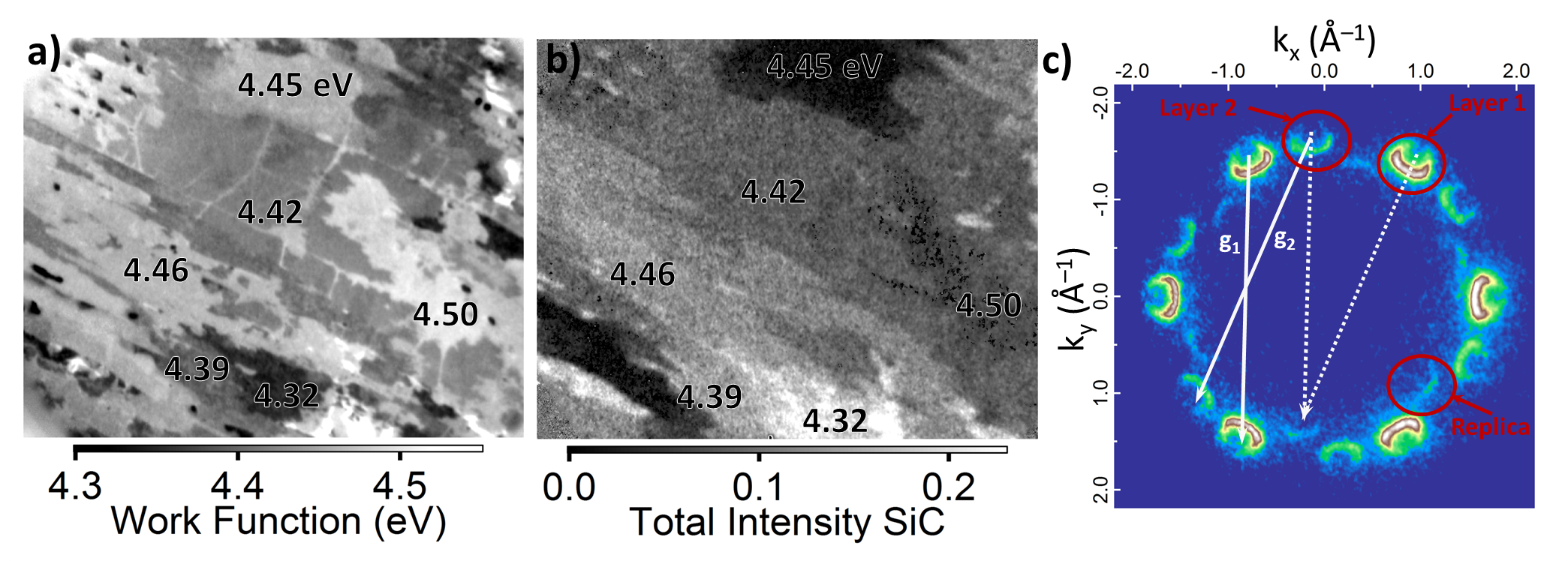
Figure 1: a) Work function map of a 53 μm FoV, using a photon energy of 654.3 eV. b) Intensity map (arbitrary units) of the SiC substrate component of C 1s spectrum after background subtraction for a FoV of 34 μm. c) Constant energy cut in the k-space below the Dirac point, acquired at a binding energy of 1.3 eV, for a graphene bilayer area.
Thanks to the easy switching between the real space and the reciprocal space imaging modes of the NanoESCA (Omicron Nanotechnology), it is possible to obtain the complete band structure of a given area down to 10 µm2, by inserting a field aperture (FA) to select the desired region. A constant energy cut of a graphene bilayer in the k-space below the Dirac point is presented in figure 1c. It shows the presence of two sets of Dirac cones, with the well-known sixfold symmetry. They are attributed to two commensurately rotated graphene sheets, with a rotation angle of 21.9°. A fainter feature presenting also a sixfold symmetry, which appears inside the radius of the most intense ones, is due to a diffraction resulting from the supercell (g1 and g2) formed by the commensurate rotations, as shown in the figure 1c. The reciprocal space imaging mode of the NanoESCA allows immediate visualization of these diffracted cones because it probes all wave vectors parallel to the sample surface.
Dark field imaging
Dark field imaging has been performed using focused He lamp (He I =21.2 eV), on such epitaxial graphene sample grown on a SiC(000-1) substrate. The real space image of the FoV at the photoemission threshold is shown in figure 2a. Figure 2b presents a constant energy cut of the band structure, averaged over the whole FoV. Six commensurate rotation angles are observed (a-f). The contrast aperture in the diffraction plane of the microscope has then been closed to a diameter of 0.11 Å-1 at each of the Dirac cones and the microscope has been switched back to the real space mode. The corresponding real space image shows the spatial origin of photoelectrons for a specific emission angle. By repeating this experiment for each rotational angle, a spatial distribution of the commensurate rotations has been determined (figure 2c). The Dirac cones at the K and K’ point of the first Brillouin zone, typical of graphene, can therefore be used to determine a real spatially-resolved map as function of the photoelectron wave vector.

Figure 2: a) Real space image of the FoV at the photoemission threshold. b) Constant energy cut in the k-space below the Dirac point showing the commensurately rotations of the graphene sheets. c) Reconstructed valence band image from the sum of the dark field images, acquired for the six commensurate rotation angles.
The PEEM study of epitaxial graphene on SiC(000-1) allows the correlation of spatial imaging, which links the WF variation to the number of graphene layer along with its interface chemistry, and to the local band structure, highlighting diffraction effects due to commensurate rotations of the graphene sheets. Dark field PEEM completes the information with a spatially resolved map of the commensurately rotated graphene sheets.
For more information, read the following paper:
Microscopic correlation between chemical and electronic states in epitaxial graphene on SiC(000-1), C. Mathieu, N. Barrett, J. Rault, Y. Mi, B. Zhang, W. A. de Heer, C. Berger, E. Conrad and O. Renault, Physical Review B 83, 235436 (2011).
Laboratory-based real and reciprocal space imaging of the electronic structure of few layer graphene on SiC(000-1) using photoelectron emission microscopy, N. Barrett, K.Winkler, B.Kromker, E.H.Conrad, Ultramicroscopy 130, 94 (2013).
Microscopic chemical and electronic structure of few layer graphene on SiC(000-1), C. Mathieu and N. Barrett, PICO, The Omicron Nanoscience Newsletter 17, 6-8 (2013)
« Back to the Group page « Back to the Oxides page
Surface polarization charge in ferroelectric (FE) materials can be screened by a variety of mechanisms: intrinsic (charge carriers or defects in the bulk), extrinsic (chemical environment or adsorbates), domain ordering, or even a combination of the above. Chemisorption of OH- and protons can lead to important changes in the electrical boundary conditions and water film can play an active role in domain switching. Photo-generated charge carriers can also efficiently screen the surface and interface polarization charge and hence the depolarizing field. The photo-generated pair lifetimes depend on the FE surface topology and the polarization state can influence, for example, redox reactions

The UV-induced DNA lesions at mutational hotspots are not randomly distributed but depend on the base sequence around them. This effect could be related to the redistribution of the electronic excitation energy among the bases. During the past term, we had evidenced that ultrafast energy transfer takes place in model duplexes with repetitive base sequence; this process is possible because the initially populated states are delocalized on more than one base (excitons). It was predicted that this phenomenon should not occur in natural DNA since it is a highly disordered system. Studying the fluorescence of natural DNA, we showed that this prediction was not correct. In this case, the energy transfer process can be mediated by interconversion between ππ* states and charge transfer states. As a result ππ* excitations exhibit multiscale decay, from the femtosecond to the nanosecond time-scale.
The figure shows how photon absorption populates exciton states which may be trapped by charge transfer states. Charge separation and charge recombination to ππ* states gives rise to delayed fluorescence (bold green). Minor contributions to ππ* fluorescence arise during intraband scattering and/or localization of the excitons (thin green).
Natural DNA publications:
I. Vaya, T. Gustavsson, F.A. Miannay, T. Douki, D. Markovitsi: Fluorescence of Natural DNA: From the Femtosecond to the Nanosecond Time Scales, J. Am. Chem. Soc., 132: 11834. 2010.
I. Vayá, T. Gustavsson, T. Douki, Y. Berlin, D. Markovitsi: Electronic Excitation Energy Transfer between Nucleobases of Natural DNA, J. Am. Chem. Soc., 134: 11366. 2012.
We use time-resolved fluorescence spectroscopy from the femtosecond to the nanosecond time scales to study the dynamics of the interaction between various types of drugs (anti-inflammatory, antitumor, antidiabetic..) and biomolecules (DNA, G-quadruplexes, aninoacids, glycogen…).
These studies are performed in the frame of SLIC/LaserLab Europe in collaboration with colleagues from Germany, Spain, Italy and Greece.
Head of the Team: Lionel Poisson
This team is interested in the ultrafast reaction dynamics of perturbed systems (on the 10fs to 100 ps timescale). Initially devoted to isolated species (gas phase), this laboratory is more and more interested in more complex systems clause to the condensed phase: radicals, microsolvated molecules, nanoparticles,…
The goal is to characterize the whole dynamics of a defined system, investigating the relaxation dynamics of all its electronic structures. This is called the “dynamic mapping” of the molecule. The understanding of the results collected goes through theoretical calculations. At least the local environment of the chromophore has to be evaluated by molecular dynamics calculations. Since the photoelectron spectroscopy is used both for the dynamics and spectroscopic investigations, knowing the electronic and vibrational spectroscopy of the ion is also requested.
Head of the team: Marc Briant/Marc-André gaveau
The general objective is to unravel through which mechanisms solvation affects the dynamics of reactions. Both reactions of electronically excited and ground state species are considered. Two set-up are used for this purpose:
Head of the team: Christian Angelié/Jean-Maïk Soudan
The general objective is to give a realistic numerical basis to fundamental concepts such as phase transition, chemical segregation and auto organization in Iron/Carbon systems, in relation with the CNT growth on iron catalysts. Novel algorithms and home-made codes are developed to treat of clusters carrying up to a few thousands of atoms. This work develops along two lines:
In the framework of an internal CEA program dedicated to the liquid-liquid extraction for nuclear waste treatment (or primary extraction of uranyl), we have fully characterized the structure of the organic phase with its influence on the phase stability[1],[2] and more recently on the extraction efficiency[3]. Extraction is related to solubilization properties[4] where surfactant and hydrotrope can be used in closed connection to enhance the transfer[5]. In such processes, the liquid-liquid interface plays a key role even though its specific influence is not fully understood. Recently, we took benefit of microfluidic tools to control the interface by making the interfacial reactions predominating over bulk ones. Dedicated home-made chips have shown the possibility to follow kinetic but also to control the shearing properties of the interface
[1] Chapter 7 for Ion Exchange and Solvent Extraction F. Testard, P. Bauduin, L. Berthon, Th. Zemb. Ed B. Moyer, CRC Press, chap 7, P381 (2009).
[2] Berthon L, Testard F, Martinet L, Zemb T, Madic C., C. R. Chimie (2010), 13 1326–1334
[3] Dourdain, S; Hofmeister, I; Pecheur, O; Dufreche, JF; Turgis, R; Leydier, A; Jestin, J; Testard, F; Pellet-Rostaing, S; Zemb, T Langmuir (2012), 28 11319-11328.
[4] Kunz, W., Testard, F., Zemb, Th., Langmuir, (2009), 25(1), 112-115.
[5] Bauduin, P., Zemb, Th., Testard, F., J. Phys. Chem. B (2008) 112, 12354-12360.
Supported lipid bilayers offer a unique configuration where a single bilayer, accessible to other molecules like, for example, proteins, peptides or DNA, is supported on a solid substrate. Beyond their interest for biosensor technology, the access they give to a flat immobilized membrane makes them highly relevant for fundamental studies in biophysics and membrane biology. In particular, they provide a unique way to finely characterize the interactions between membranes and their environment, which are not only crucial for membrane fusion and trafficking, endo- and exocytosis, but also fascinating from the physical point of view.
Membranes indeed exhibit extremely complex interactions with their environment, where molecular scale enthalpic and fluctuation related entropic contributions are inextricably involved. In particular, the effect of confinement has been now discussed for 40 years without finding a definitive answer. Helfrich (1973) first realized that, in addition to the “direct'' electrostatic, van der Waals and hydration forces, the long-range “effective'' steric interaction generated by the thermal fluctuations of confined flexible membranes is an essential contribution to the total free energy of interaction. Pure hard wall interaction (hard confinement) was first considered but is not a realistic description of real systems, and especially of living ones. Confinement by a “soft'' potential was treated either by using self-consistent methods leading to effective exponentially decaying potentials, or by estimating average values within a full statistical mechanics approach. Which functional form should be used to describe entropic repulsion in real experimental situations remains, however, an open question.
We have determined, by grazing incidence x-ray scattering, the interaction potential between two lipid bilayers, one adsorbed on a solid surface and the other floating close by[1]. We find that interactions in this highly hydrated model system are two orders of magnitude softer than in previously reported work on multilayer stacks. This is attributed to the weak electrostatic repulsion due to the small fraction of ionized lipids in supported bilayers with a lower number of defects. Our data are consistent with the Poisson-Boltzmann theory, in the regime where repulsion is dominated by the entropy of counter-ions. We also have a unique access to very weak entropic repulsion potentials which allowed us to discriminate between the various models proposed in the literature. We show that our data are best described using the soft potential of Podgornik and Parsegian (1992)[2]. We further demonstrate that the interaction potential between supported bilayers can be tuned at will by applying osmotic pressure, providing a way to manipulate these model membranes, thus considerably enlarging the range of biological or physical problems which can be addressed[3].
We are currently extending these measurements to the fluctuations and destabilization of membranes in an AC electric field.
[1] L. Malaquin, T. Charitat, and J. Daillant. Eur Phys J E Soft Matter, 31(3):285–301, 2010.
[2] A. Hemmerle, L. Malaquin, T. Charitat, S. Lecuyer, G. Fragneto, and J. Daillant. Proc. Nat. Ac. Sc. , 109(49):19938–19942, 2012.
[3] G. Fragneto, T. Charitat, and J. Daillant. EUROPEAN BIOPHYSICS JOURNAL WITH BIOPHYSICS LETTERS, 41(10):863–874, 2012.
Hybrid organic-inorganic nanoparticles with well-controlled morphology are currently of great research interest. Synthetic routes leading to robust aggregates made of nanoparticles of different chemical natures which are associated in a controlled manner, i.e. number of nanoparticles and geometrical arrangement, are especially investigated. Clusters of spheres could mimic the space-filling models of simple molecules and are called “colloidal molecules”. In the framework of the TOCOMO ANR project, the strategy is based on a seeded-growth emulsion polymerization process leading to biphasic particles, which are composed of spherical silica spheres (50-400 nm) surrounded by a varying number of polystyrene (PS) nodules.
Emulsions of two immiscible fluids stabilized with solids particles, called Pickering emulsion, have been studied since the early twentieth century and the pioneering works of Ramsden[1] and Pickering[2] The irreversible adsorption of particles at the interface of the two phases gives original properties of these emulsions. Such emulsions are of primary interest in the food, cosmetics industry and oil recovery. Although it is now clear that the stabilization mechanism comes from the partial wettability of the nanoparticles by the two emulsion phases, the interface structures for such a stability mechanism is not well understood. There is a need of making a Pickering emulsion model system where the nanoparticles are well controlled as well as the emulsion size. The LIONS laboratory has developed a microfluidics platform (Fig.6) which allows preparing monodisperse tunable Pickering emulsion starting from monodisperse silica nanoparticles (NPs) of 7nm radius.
Within the ANR project ANR-06-BLAN-0276 "SISCI" (Spécificité Ionique dans les Systèmes Colloïdaux et Interfaciaux), we have explored the specific local ionic distributions in water in the vicinity of interfaces between aqueous electrolytes and external media.
Three different X-ray reflectivity techniques have been developed[1]. (i) The air-water interface has been investigated using grazing incidence x-ray fluorescence for different alkali-halide solutions[2]. The measured integrated amount of desorbed ions follows a Hofmeister series, in agreement with the surface tension behavior, and is interpreted in terms of ion-surface interaction potentials. (ii) The spatial ion distribution has been resolved at the sub-nanometer level using x-ray standing waves at the interface with a multilayer silica substrate. (iii) x-ray reflectivity analysis of polarized liquid mercury surface in contact with aqueous electrolyte has shown how the Hg-surface layering and the local ionic profiles depend on both applied potential and ion nature[3].
Carbonated mineralization as carried out by living organisms like seashells is a very intriguing process leading to crystalline materials that diffract like single crystals while adopting very sophisticated shapes. Nacre is a paradigmatic example of biomineralization, made of water-insoluble organic compartments filled with a CaCO3 mineral phase. We successively considered two model systems to mimic the influence of an organic template on mineralization: first, β-sheet peptide monolayers at the air-water interface and then giant unilamellar polymer vesicles.
Concerning the first model system, two different peptidic sequences, named LSFD and LDFD (respectively 12 and 11 amino-acid long), were designed and evaluated with respect to their ability to form β-sheet layers at the air-water interface[1] and to induce a specific CaCO3 crystallization by selecting the nucleated polymorph and/or its crystallographic orientation.[2] Although the two sequences exhibit a β-sheet conformation at the air-water interface and form 2D crystalline domains, they show unable to direct the mineralization: the selected crystalline polymorph is switched from calcite to vaterite when the interface is covered by any of the two peptidic films, but probably owing to a kinetic effect. Moreover, vaterite crystals appear as a 3D powder with no preferred orientation with respect to the organic “template”. Surprisingly, the Langmuir film made from the more acidic peptide (LDFD) remains stable upon mineralization whereas the LSFD peptide film gets destabilized, likely through an adsorption of the peptides on the growing crystallites.
Titanium and its alloys are widely used in aeronautical, marine and chemical industries for their good mechanical properties, high resistance to corrosion, especially in sea water or human body, and low density, about 60% of steel density. However, tribological properties of titanium surface are poor with highly unstable friction coefficients and adhesive wear mechanisms which lead mechanical parts to seize up. Surface treatments are required to improve surface properties, according to the envisioned application.
Nitriding and carburizing are the most commonly used thermochemical treatments, but they must be done in highly oxygen-free atmospheres to avoid titanium oxidation. This rules out the possibility of local treatments. Laser induced modifications offer an alternative tool for modifying the surface composition by insertion of light elements (oxygen, nitrogen, carbon) present in the reactive atmosphere. Modified layers must have a high content of nitrogen to be hard enough to stand up to surface friction, while oxygen, localized in less crystallized phases, is also needed to accommodate friction without failure. Oxynitride formation appears then as ideal to reach optimal resistance.
Sintering constitutes an important step in the production of ceramic materials. Whatever the nature of the ceramic material considered and its field of application (nuclear ceramics, fuel cell ceramics, etc.), one of its essential characteristics is its microstructure (size and shape of grains, distribution of porosity residual). The microstructure directly affects the physico-chemical properties of the material.
We have examined the role of sintering conditions on La1.95Sr0.05Zr2O6.975 material, considered as a promising proton-conductive fuel cell electrolyte [1]. Conventional sintering methods (UP Uniaxial Drying, IP Isostatic Pressing, HP Hot Pressing) lead to the production of low density pellets (relative densities in the range 46% to 78%) with consequent increase of crystallite size (75-235 nm). In addition, X-ray diffraction experiments and ion beam analyzes revealed a surface decomposition of the pellets obtained through conventional methods (Figure 1). The flash sintering method (SPS Spark Plasma Sintering) made it possible to obtain totally densified pellets (96%) with a crystallite size of the order of one hundred nanometers. Figure 2 shows the crystallite sizes (calculated from Williamson-Hall's law) and the densities obtained for each of the sintered pellets.
The LCCEF has been developing the amide chemistry for a long time due to the great chemical opportunities afforded by the NR2 ligands. In particular, the bis(trimethylsilyl)amide ligand (N* = N(SiMe3)2), ubiquitous in coordination chemistry, is able to stabilize metal centres in their lowest and highest oxidation states and can be substituted with proton acidic molecules, so that bis(trimethylsilyl)amide compounds are valuable starting materials for inorganic and organometallic syntheses. In the presence of a base the “MXN*” complexes are often transformed into metallacycles [M(κ2(C,N)−CH2SiMe2N{SiMe3})] following γ-CH deprotonation and HX elimination.
Alexandre Hervé, Pierre Thuéry, Michel Ephritikhine, Jean-Claude Berthet
L’ion cyanure CN− est certainement l'un des ligands les plus utilisés en chimie de coordination des métaux de transition d. De nombreuses études ont montré l’intérêt des complexes cyanures dans des domaines très variés allant de la biologie aux nanomatériaux. En plus d’une riche chimie de coordination liée aux divers modes de coordination du group CN, les complexes cyanures présentent bien souvent de remarquables propriétés magnétiques, photoluminescentes et/ou de conductivité. Au contraire de celle des métaux d, la chimie des cyanures des métaux f (lanthanides et actinides) n’a été que très peu considérée.
Le laboratoire LCCEf s’intéresse depuis quelques années au développement de cette thématique à partir de précurseurs organométalliques ou comportant des ligands azotés, et a mis en évidence le potentiel du ligand CN−,
- pour stabiliser les nombreux degrés d’oxydation de l’uranium1-4
- et former des espèces inattendues (métallocènes linéaires,2,3 complexe cyclopentadiènylique de l’uranyle4) bouleversant ainsi les mentalités et ouvrant de nouvelles possibilités notamment en chimie organométallique.
Les études actuelles concernent la formation de briques moléculaires mono ou polycyanures, intéressantes pour de nouveaux développements en chimie de coordination, mais surtout susceptibles de conduire à la formation de clusters et d’agrégats homo ou polymétalliques originaux dont les propriétés photochimiques (magnétisme et luminescence) seront étudiées. Ces études expérimentales couplées à des calculs théoriques favoriseront également une compréhension plus fine de la liaison Actinide-ligand nécessaire sur les plans fondamental et appliqué (Nucléaire).
The parahydrogen induced polarization (PHIP) method is based on the non-Boltzmann distribution of nuclear spin states following the hydrogenation of a substrate by parahydrogen. Absorptive and/or emissive NMR signals can be greatly enhanced, up to several orders of magnitude as compared to thermally polarized molecules.
The research in this field is part of the expertise of LSDRM in its effort to increase NMR sensitivity.
Dihydrogen, initially made of 1/4 of parahydrogen and 3/4 of orthohydrogen, a proportion that does not induce any hyperpolarization, is cooled to -196°C in the presence of a ferric catalyst, thanks to an home-made apparatus. The resulting gas contains about one half of parahydrogen, and may be use to obtain hyperpolarized spectra.
A first example: the method named "signal amplification by reversible-exchange" (SABRE) is used here to increase the aromatic signals of N,N-dimethylnicotinamide. In SABRE, a catalyst reversibly binds dihydrogen and the aromatic molecule.
The multiband nature of the iron-based superconductors is a key factor to understanding their physical properties. We have performed a complete study of the charge transport in Ba(Fe1-xCox)2As2 single crystals, in connection with a determination of their electronic structures by photoemission experiments.
In the new Fe-based pnictide superconductors discovered in 2008, the appearance of high-Tc superconductivity in close proximity to the antiferromagnetic phase has been taken as the signature of unconventional superconductivity. It seems now well established that magnetism and superconductivity are directly connected to the peculiar features of the electronic structures of these compounds, which are characterized by small hole and electron pockets. The transport properties of the prototypical Ba(Fe1-xCox)2As2 have been studied throughout the electron doped phase diagram as fine tuning of Co content can be achieved in sizeable single crystals.
Sintering constitutes an important step in the production of ceramic materials. Whatever the nature of the ceramic material considered and its field of application (nuclear ceramics, fuel cell ceramics, etc.), one of its essential characteristics is its microstructure (size and shape of grains, distribution of porosity residual). The microstructure directly affects the physico-chemical properties of the material.
We have examined the role of sintering conditions on La1.95Sr0.05Zr2O6.975 material, considered as a promising proton-conductive fuel cell electrolyte [1]. Conventional sintering methods (UP Uniaxial Drying, IP Isostatic Pressing, HP Hot Pressing) lead to the production of low density pellets (relative densities in the range 46% to 78%) with consequent increase of crystallite size (75-235 nm). In addition, X-ray diffraction experiments and ion beam analyzes revealed a surface decomposition of the pellets obtained through conventional methods (Figure 1). The flash sintering method (SPS Spark Plasma Sintering) made it possible to obtain totally densified pellets (96%) with a crystallite size of the order of one hundred nanometers. Figure 2 shows the crystallite sizes (calculated from Williamson-Hall's law) and the densities obtained for each of the sintered pellets.
Heterogeneous samples are usually studied using solid-state NMR methods and while the sample is spinning at the magic angle. This is problematic for many cases, where the sample cannot be spun, as in MRI. The alternative methodology of spinning the magnetic field around a static sample has been proposed since the 60's, but not yet successfully applied. Our goal is to develop the methodology and the instrumentation in order to perform magic angle field spinning and answer questions related to the monitoring of metabolism in living matter as well as the structure and function of complex systems like batteries, porous media and fuel cells.
The parahydrogen induced polarization (PHIP) method is based on the non-Boltzmann distribution of nuclear spin states following the hydrogenation of a substrate by parahydrogen. Absorptive and/or emissive NMR signals can be greatly enhanced, up to several orders of magnitude as compared to thermally polarized molecules.
The research in this field is part of the expertise of LSDRM in its effort to increase NMR sensitivity.
Dihydrogen, initially made of 1/4 of parahydrogen and 3/4 of orthohydrogen, a proportion that does not induce any hyperpolarization, is cooled to -196°C in the presence of a ferric catalyst, thanks to an home-made apparatus. The resulting gas contains about one half of parahydrogen, and may be use to obtain hyperpolarized spectra.
A first example: the method named "signal amplification by reversible-exchange" (SABRE) is used here to increase the aromatic signals of N,N-dimethylnicotinamide. In SABRE, a catalyst reversibly binds dihydrogen and the aromatic molecule.











